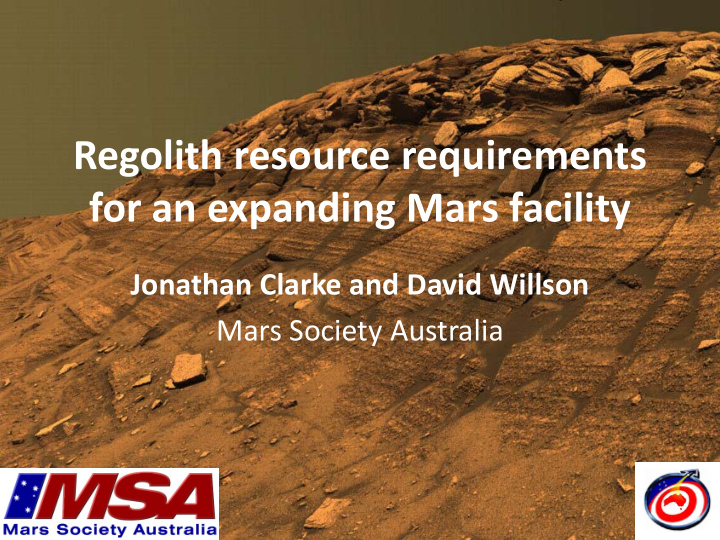



Regolith resource requirements for an expanding Mars facility Jonathan Clarke and David Willson Mars Society Australia
The Issue • What scope of mining will be needed to support Mars operations? • How will these change as the scale of operations increase? • What equipment will be needed to support this? • How can this be tested on Earth? Brian Versteeg
Staging • S1 – initial missions (4-6 crew) - FMARS analogue • S2 – Follow up missions/semi - permanent station (6-12 crew) – MDRS analogue • S3 – Permanent facility (15- 100 crew) – Resolute analogue
ISRU plant Berm Landing pad Excavator
Regolith Requirements Regolith water-based ISRU (propellants, O2, crew water) MISSION CREW MODE TONNES TONNES TONNES DAILY BUCKETS BUCKETS H2 H2O REGOLITH* TONNES PER DAY PER DAY (2 YRS) RANGER BOBCAT Mars Oz 4 Semi- 1.6 14.4 144 0.2 1 direct Mars 4 Direct 8.6 77.4 774 1.1 5 1 Direct v2 SpaceX ITS 100 Direct 63 563 5630 7.7 34 8 v1^ *Assuming 10% H2O ^Based on L Pieniazek & N Vlietstra, pers. comm.
Other requirements Clearing Excavation Fill Foundations
Demand will increase exponentially with size of settlement! Resolute, Nunavut
Cut and fill Platforms Trenching and pipe laying Causeways
Site levelling Track clearing/grading Site levelling Draglines Buried infrastructure (radiation protection) ISRU plant Site levelling Site levelling
Equipment Requirements OPERATION INITIAL MISSIONS PERMANENT STATION Excavation Bucket on utility vehicle Face excavator, trench excavator (common earth moving chassis) Trenching Trench excavator on utility Trench excavator, bucket wheel, vehicle (common earth moving chassis) Levelling Blade on utility vehicle Bulldozer (common earth moving chassis) Transport Tip tray on utility vehicle Tip truck (common transport chassis) Augering/ Auger or drill on utility Drill rig (common transport chassis) drilling vehicle Rock breaker Attachment to common earth moving chassis) Utility vehicle Earth moving chassis Transport chassis
Even so, Mars exploration and initial settlements will not require enormous mining capacity
EXAMPLE OF SMALL SCALE MINING – RALLINGA TIN MINE, SW TASMANIA • Alluvial tin 0.5 kg (cassiterite) per tonne • 1.5 m overburden, pay gravels 0.5 m thick • ~5 tonnes cassiterite produced each year • Plant processed ~5 tonnes per hour, 36 hrs per week • “Mum and Dad” operation • ~ 10,000 tonnes of gravel & 22,000 tonnes overburden excavated yearly • Area effected annually 10,000 square metres (100 X 100 m) REGOLITH EXTRACTION ON MARS WILL BE SMALLER THAN SMALLEST TERRESTRIAL MINES
Meeting Requirements Analogue examples Bobcat S590 Dingo Toolcat Utility vehicle Bucket = 954 kg Bucket = 340 kg Bucket = 228 kg Bucket = 590 kg
Research possibilities • The small scale of mining to needed to support initial missions (<10 tonnes per day) allows full scale testing – avoiding scaling issues. • A diversity of off-the-shelf hardware can be adapted for low to medium fidelity testing (including electric and tele-operated systems). • The robust nature of the off-the-shelf equipment will allow testing in a wide range of field environments. • The full scale nature testing of mining equipment also allows processing plant to be similarly tested at full scale. • Ideal for student team projects and corporate sponsorship!
Conclusions • Initial regolith mining will likely be minor site works and water extraction with water extraction dominating • Site works will likely dominate needs of larger settlements, even with increased water extraction for large scale propellant manufacture • Even so, daily regolith handling rates will be low • Mining and processing concepts can be tested at full scale with off-the-shelf technology
Questions
Recommend
More recommend